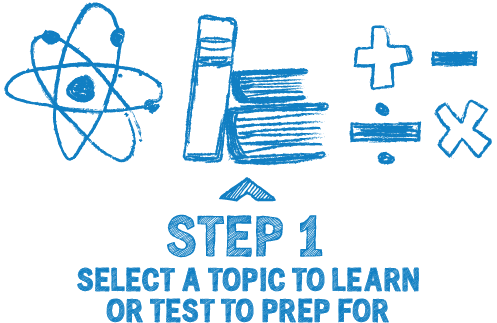Force and Motion
Grade 6 Science Worksheets
Force refers to any influence that can cause an object to accelerate or change its motion. It can be a push or a pull and is typically measured in Newton’s (N). Forces can be exerted by objects or fields, such as gravity or magnetic fields, and is a vector quantity.
Table of Contents:
- Laws of Motion
- Examples
- Force and Motion
- FAQs
Force and Motion - Grade 6 Science Worksheet PDF
This is a free printable / downloadable PDF worksheet with practice problems and answers. You can also work on it online.
|
|
Untimed |
|
Sign up with your email ID to access this free worksheet.
"We really love eTutorWorld!"
"We really love etutorworld!. Anand S and Pooja are excellent math teachers and are quick to respond with requests to tutor on any math topic!" - Kieran Y (via TrustSpot.io)
"My daughter gets distracted easily"
"My daughter gets distracted very easily and Ms. Medini and other teachers were patient with her and redirected her back to the courses.
With the help of Etutorworld, my daughter has been now selected in the Gifted and Talented Program for the school district"
- Nivea Sharma (via TrustSpot.io)
Force can have various effects such as:
- change in shape and structure
- change in state- rest to motion and motion to rest
- change in direction
- change in speed
Motion, on the other hand, refers to the movement of an object in space over time. It can be described using various measurements, including distance, displacement, speed, velocity, and acceleration. Motion is influenced by the forces acting on an object, according to Newton’s laws of motion.
In physics, the relationship between force and motion is described by Newton’s laws of motion. These laws state that an object at rest will remain at rest unless acted upon by an unbalanced force (the first law), the acceleration of an object is directly proportional to the force applied to it and inversely proportional to its mass (the second law), and for every action, there is an equal and opposite reaction (the third law).
Laws of Motion
There are three laws of motion in physics, each with its own formula and applications.
Newton’s First Law of Motion: This law states that an object at rest will remain at rest, and an object in motion will remain in motion at a constant velocity unless acted upon by an external force.
Application: This law is particularly useful in understanding the behavior of objects that are not subject to external forces, and can be used to explain phenomena such as the motion of planets in space.
Newton’s Second Law of Motion: This law states that the acceleration of an object is directly proportional to the force applied to it and inversely proportional to its mass.
Application: This law is particularly useful in understanding the behavior of moving objects, and can be used to calculate the force required to achieve a certain acceleration, or the acceleration that will result from a certain force.
Newton’s Third Law of Motion: This law states that for every action, there is an equal and opposite reaction.
Application: This law is particularly useful in understanding the behavior of interacting objects, and can be used to explain phenomena such as the motion of projectiles and the behavior of colliding particles.
Coulomb’s Law: This law states that the force between two charged particles is directly proportional to the product of their charges and inversely proportional to the square of the distance between them.
Application: This law is particularly useful in understanding the behavior of charged particles, and can be used to calculate the force of attraction or repulsion between two charged particles.
Hooke’s Law: This law states that the force required to extend or compress a spring is directly proportional to the distance it is stretched or compressed.
Application: This law is particularly useful in understanding the behavior of elastic materials, and can be used to calculate the force required to stretch or compress a spring to a certain length.
Overall, these laws of force are essential in understanding the behavior of physical systems in the natural world, and have a wide range of applications in fields such as engineering, physics, and astronomy.
“There have been times when we booked them last minute, but the teachers have been extremely well-prepared and the help desk at etutorworld is very prompt.
Our kid is doing much better with a higher score.”
6th Grade Tutoring
eTutorWorld offers Personalized Online Tutoring for Math, Science, English, and Standardised Tests.
Our Tutoring Packs start at just under $22.49 per hour, and come with a moneyback guarantee.
Schedule a FREE Trial Session, and experience quality tutoring for yourself. (No credit card required.)
Force and Motion
Force and motion are closely related. In fact, the study of the relationship between force and motion is a fundamental part of physics.
Simply put, force is a push or pull on an object, while motion is a change in the position of an object over time. When a force is applied to an object, it can cause the object to accelerate, decelerate, or change direction. In other words, the force can cause a change in the object’s motion.
According to Newton’s Second Law of Motion, the force acting on an object is directly proportional to the acceleration of the object. This means that a greater force will result in a greater acceleration of the object. Conversely, a smaller force will result in a smaller acceleration.
Additionally, the direction of the force will affect the direction of the object’s motion. If the force is applied in the same direction as the object’s motion, it can increase its speed. If the force is applied in the opposite direction to the object’s motion, it can decrease its speed or bring it to a stop.
Overall, force and motion are intertwined in a cause-and-effect relationship. The application of force can cause a change in the motion of an object, and the motion of an object can also affect the force acting on it. The study of force and motion is important for understanding the behavior of objects in the physical world, from the motion of planets and stars to the motion of everyday objects such as cars and people.
Do You Stack Up Against the Best?
If you have 30 minutes, try our free diagnostics test and assess your skills.
FAQs
What is force?
Force is a push or pull that can cause an object to accelerate, decelerate, or change direction.
What is motion?
Motion is a change in the position of an object over time.
What is the relationship between force and motion?
The relationship between force and motion is that the application of force can cause a change in the motion of an object, and the motion of an object can also affect the force acting on it.
What is Newton's first law of motion?
Newton’s first law of motion, also known as the law of inertia, states that an object at rest will remain at rest, and an object in motion will remain in motion with a constant velocity unless acted upon by an unbalanced force.
What is Newton's second law of motion?
Newton’s second law of motion states that the acceleration of an object is directly proportional to the net force acting on it and inversely proportional to its mass.
What is Newton's third law of motion?
Newton’s third law of motion, also known as the law of action and reaction, states that for every action, there is an equal and opposite reaction.
What is friction?
Friction is the force that opposes motion between two surfaces in contact.
How does friction affect motion?
Friction can slow down or stop an object in motion by opposing its movement.

Kathleen Currence is one of the founders of eTutorWorld. Previously a middle school principal in Kansas City School District, she has an MA in Education from the University of Dayton, Ohio. She is a prolific writer, and likes to explain Science topics in student-friendly language. LinkedIn Profile
Affordable Tutoring Now Starts at Just $22.49
eTutorWorld offers affordable one-on-one live tutoring over the web for Grades K-12. We are also a leading provider of Test Prep help for Standardized Tests (SCAT, CogAT, MAP, SSAT, SAT, ACT, ISEE, and AP).
What makes eTutorWorld stand apart are: flexibility in lesson scheduling, quality of hand-picked tutors, assignment of tutors based on academic counseling and diagnostic tests of each student, and our 100% money-back guarantee.
Whether you have never tried personalized online tutoring before or are looking for better tutors and flexibility at an affordable price point, schedule a FREE TRIAL Session with us today.
*There is no purchase obligation or credit card requirement
Grade 6 Science Worksheets
- Inquiry process
- Nature of Science
- Scientific Inquiry
- Inquiry, Analysis and Problem Solving
- Ethical Practices
- Science and Society
- Biotic and Abiotic Factors
- Impact of Organisms
- Adaptation
- Spheres of Earth
- Natural Resources
- Environmental Issues
- Conservation of Earth
- Understanding Technology
- Abilities To Do Technological Design
- Structure of Earth
- Solar System
- Rocks and Fossils
- Earth Systems
- Plate Tectonics
- Evolution
- Magnetic Field of Earth
- Geologic Time
- Materials and Processes That Shape a Planet
- Astronomy
- Ecology
- Energy
- Kinetic and Potential Energy
- Energy Transfer
- Matter and its Structure
- States of Matter
- Physical and Chemical Changes
- Force and Motion
- Electricity and Magnetism
- Wave Interactions
- Sound
- Light
- Introduction to Life Science
- The Origin & History of Life On Earth
- Plant and Animal Cells
- Parts of a Cell
- The Cell Cycle
- How Living Organisms Get Energy
- Classification of Organisms
- How Plants Grow & Reproduce
- The Human Respiratory System
- The Human Cardiovascular System
- The Human Digestive System
- The Human Endocrine Systems
- The Human Nervous System
- The Human Muscular System
- The Human Skeletal System
IN THE NEWS

Our mission is to provide high quality online tutoring services, using state of the art Internet technology, to school students worldwide.
Online test prep and practice
SCAT
SSAT
ISEE
PSAT
SAT
ACT
AP Exam
Science Tutoring
Physics Tutoring
Chemistry Tutoring
Biology Tutoring
Math Tutoring
Pre-Algebra Tutoring
Algebra Tutoring
Pre Calculus Tutoring
Calculus Tutoring
Geometry Tutoring
Trigonometry Tutoring
Statistics Tutoring
Quick links
Free Worksheets
Fact sheet
Sales Partner Opportunities
Parents
Passive Fundraising
Virtual Fundraising
Our Expert Tutors
Safe and Secure Tutoring
Interactive Online Tutoring
After School Tutoring
Elementary School Tutoring
Middle School Tutoring
High School Tutoring
Home Work Help
Math Tutors New York City
Press
©2022 eTutorWorld Terms of use Privacy Policy Site by Little Red Bird
©2022 eTutorWorld
Terms of use
Privacy Policy
Site by Little Red Bird
















